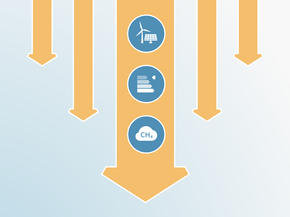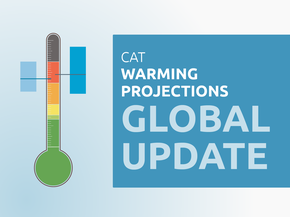Targets
Target Overview
India officially submitted two of the four 2030 targets announced by Prime Minister Modi in 2021 (at COP26) as part of its August 2022 NDC update. These two targets are: to reduce its emissions intensity by 45% below 2005 levels by 2030 (excluding LULUCF) and to increase the share of non-fossil power capacity to 50% by 2030.
On paper, both are stronger targets than the original NDC submissions, which had a 33-35% emissions intensity and a 40% non-fossil power capacity target, but neither will drive real world emission reductions. The other two targets, which were not submitted, were a 500 gigawatt (GW) non-fossil capacity target in the power sector and a commitment to reduce emissions by one billion tonnes by 2030 which, while heading in the right direction, are also unlikely to drive real world emission reductions in any substantial way (see here for details).
The target of creating a cumulative 2.5-3 GtCO2 carbon sink by 2030 is unchanged and was included in both the first and the updated NDC.
| INDIA - Main climate targets |
|---|
| 2030 unconditional NDC target | |||
|---|---|---|---|
| Formulation of target in NDC | Emissions intensity of 45% below 2005 levels by 2030 | ||
| Absolute emissions level in 2030 excl. LULUCF |
4.99 GtCO2e [115% above 2010] |
||
| Status | Submitted on 26 August 2022 | ||
| 2030 conditional NDC target | |||
|---|---|---|---|
| Formulation of target in NDC | 50% cumulative electric power installed capacity from non-fossil fuel-based energy resources by 2030 | ||
|
Absolute emissions level in 2030 excl. LULUCF |
4.4–4.8 GtCO2e [89–108% above 2010] |
||
| Status | Submitted on 26 August 2022 | ||
| Net zero & other long-term targets | |||
|---|---|---|---|
| Formulation of target | India has pledged to become net zero by 2070 | ||
|
Absolute emissions level in 2050 excl. LULUCF |
N/A* | ||
| Status | Long Term Low Emissions Development Strategy (LT-LEDS) submitted in November 2022 | ||
* For details on our Optimistic Target global temperature estimate for India, please see the Assumptions tab.
NDC updates
India has not submitted an updated NDC since 2022 and is yet to submit its 2035 target. India’s original 2015 NDC had three main mitigation elements: an emissions intensity target, a non-fossil fuel-based electric power capacity target, and the enhancement of carbon sinks. India strengthened the emissions intensity and non-fossil capacity targets as part of its 2022 NDC update, going from 33–35% to 45% for the intensity target and from 40% to 50% for the non-fossil capacity target by 2030. The carbon sink target was unchanged.
While the targets are stronger on paper, India will over-achieve them with its current level of climate action and thus the targets will not drive further emissions reductions. The rating of India’s NDC against its fair contribution did improve by one category to “Insufficient” with the update in targets.
In essence, India replaced its unambitious first mitigation targets with targets close to its current level of climate action. Our estimate for its 2030 emissions based on current policies is consistent with a 51–52% reduction in emissions intensity below 2005 levels and a non-fossil capacity target of around 60%.
However, these efforts fall short of what is needed to align with a 1.5°C pathway. Achieving deeper emissions cuts by 2030 will require a significant scaling up of ambition, which, in turn, depends on the availability of international climate finance. To reflect this dependency more clearly, India should articulate higher conditional targets explicitly tied to climate finance support, making the role of external funding a central component of its mitigation strategy.
500 GW target
At COP26, Prime Minister Modi also announced a 500 GW non-fossil capacity target. This target was not included in the official NDC update, but is still referred to in national documents (Ministry of Power, 2022b). Both of our current policy projections include more than 500 GW of non-fossil capacity in 2030, thus this target will not drive any additional real-world action.
Lifestyle changes
India has long stressed the importance of lifestyle changes to achieve climate-friendly development. In its first NDC, it committed to propagating "a healthy and sustainable way of living based on traditions and values of conservation and moderation." It has expanded this commitment in its updated NDC to include "a mass movement for ‘LIFE’ – Lifestyle for Environment." In October 2022, it launched "Mission LiFE" to promote sustainable and healthy lifestyle and seeks to mobilise at least a billion people by 2028 (NITI Aayog, 2022). Due to the diverse and varied nature of individual measures, we have not quantified this aspect of the NDC.
| INDIA — History of NDC updates | First NDC | 2022 NDC update submission |
|---|---|---|
| 1.5°C compatible |
|
|
| Stronger target | N/A |
|
| Economy-wide coverage |
|
|
| Fixed/absolute target |
|
|
| First NDC | 2022 NDC | |
|---|---|---|
| Formulation of target in NDC |
Unconditional target: Emissions intensity target of 33–35% below 2005 levels by 2030 Conditional target: 40% cumulative electric power installed capacity from non-fossil fuel-based energy resources by 2030 |
Unconditional target: Emissions intensity target of 45% below 2005 levels by 2030 Conditional target: 50% cumulative electric power installed capacity from non-fossil fuel-based energy resources by 2030 |
| Absolute emissions level in 2030 excl. LULUCF |
Unconditional target: 5.9–6.1 GtCO2e Conditional target: 4.8–5.0 GtCO2e |
Unconditional target: 4.98 GtCO2e Conditional target: 4.4–4.8 GtCO2e |
| Emissions compared to 1990 and 2010 excl. LULUCF |
Unconditional target: 154–162% above 2010 levels Conditional target: 107–115% above 2010 levels |
Unconditional target: 115% above 2010 levels Conditional target: 89–108% above 2010 levels |
| CAT rating |
Unconditional target against fair share target: Highly insufficient Conditional target against modelled domestic pathways: Highly insufficient |
Unconditional target against fair share target: Insufficient Conditional target against modelled domestic pathways: Highly insufficient |
| Sector coverage | Economy-wide | Unchanged |
| Separate target for LULUCF |
Yes To create an additional carbon sink of 2.5 to 3 GtCO2e through additional forest and tree cover by 2030 |
Unchanged |
| Gas coverage | Not specified | Not specified |
| Target type |
• Emissions intensity of GDP • Non-emissions target: Share of non-fossil fuels in power capacity |
Unchanged |
Target development timeline & previous CAT analysis
- 01 November 2021: India announced revised NDC target in COP26
CAT rating of targets
We take India’s emissions intensity target as its unconditional contribution to limiting warming to 1.5°C and rate that against what a fair contribution would be.
India has indicated that achieving the 50% non-fossil capacity target will require international support. We take this target as being conditional on international support and rate it against the level of reductions needed within India’s borders.
The CAT methodology for rating NDCs is based on GHG emissions from fossil fuels, agriculture and industrial processes. We exclude the land sector from our calculations and thus do not evaluate the contribution of India’s carbon sink expansion efforts.
We estimate that India’s 50% non-fossil capacity target would result in an emissions level of between 4.4–4.8 GtCO2e (excluding LULUCF) in 2030.
India has already achieved its 50% non-fossil capacity and is on track to achieve more than 60% non-fossil capacity by 2030 under current policies, so achieving only the 50% in the NDC would actually result in higher emissions. India has an opportunity to increase its ambition at least to the current policy level and even higher with international support.
We rate this target as “Highly insufficient” when compared to the level of reductions needed within India to be 1.5°C compatible. The “Highly insufficient” rating indicates that India’s conditional target leads to rising, rather than falling, emissions and is not at all consistent with limiting warming to 1.5°C. If all countries were to follow India’s approach, warming could reach over 3°C and up to 4°C.
Our estimate for the 50% non-fossil capacity target is based on the underlying power sector scenario of the current policy pathways. The upper bound of the power sector scenario is based on the IEA’s World Energy Outlook 2023 Stated Policies Scenario (STEPS) which also includes a non-fossil capacity target of 68% from the National Electricity Plan 2023 (NEP2023).
The lower bound of the power sector scenario is developed to reflect the slow progress of the National Electricity Plan 2023 (NEP2023) (please refer to the Assumptions section for the methodology used in estimating targets).
Substantial improvement is needed in the conditional target and India will need international support to get onto a 1.5°C compatible pathway. Even if India is not responsible for paying for all its emission reductions, it should develop plans to rapidly cut emissions conditional on sufficient international support being available, and not lock itself into a high carbon future. This would mean starting to phase out coal use, adopting emission reduction plans across the economy, and clearly specifying what international support it requires to achieve a 1.5°C compatible target.
We estimate that India’s emissions intensity target would result in an emissions level of 4.99 GtCO2e (excluding LULUCF) in 2030. This emissions level is above where we project India’s emissions to be in 2030 under current policies and action.
We rate the intensity target as “Insufficient.” The “Insufficient” rating indicates that India’s unconditional target needs substantial improvements to be consistent with limiting warming to 1.5°C. India’s target is at the least stringent end of what would be a fair share of global effort and is not consistent with the 1.5°C limit, unless other countries make much deeper reductions and comparably greater effort. If all countries were to follow India’s approach, warming would reach over 2°C and up to 3°C.
The quantification of this target varies depending on how GDP is measured and assumptions made about 2030 projections. The transparency of India’s target could be improved with further information on these elements.
Also, while an emissions intensity target may contribute to decoupling emissions from economic growth, this type of target may not be sufficient to address the urgency of climate change, as overall emissions could continue to rise.
Further information on how the CAT rates countries (against modelled domestic pathways and fair share) can be found here.
Net zero and other long-term target(s)
Prime Minister Narendra Modi announced a 2070 net zero target at COP26 in 2021. India submitted its Long-term Strategy for Low Carbon Development (LT-LEDS) at COP27 in 2022 (Government of India, 2022a; Ministry of External Affairs, 2021).
See the Net Zero tab for further information.
Further analysis
Latest publications
Stay informed
Subscribe to our newsletter




